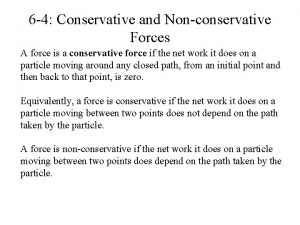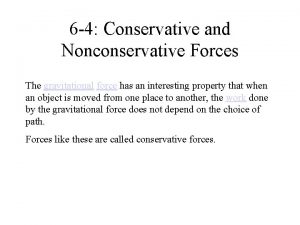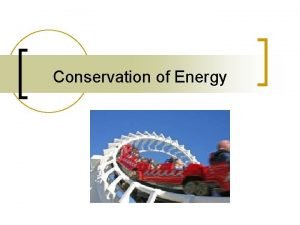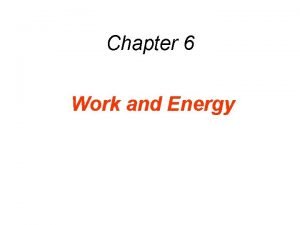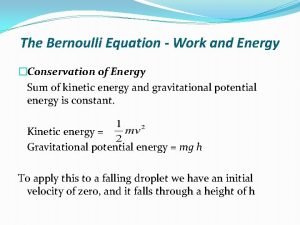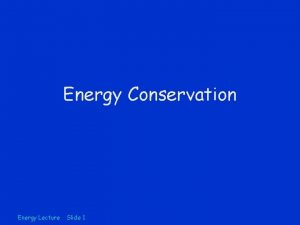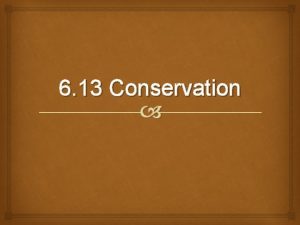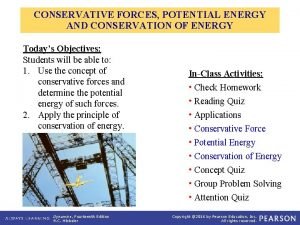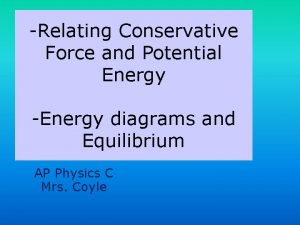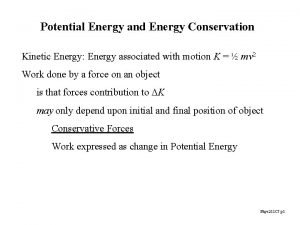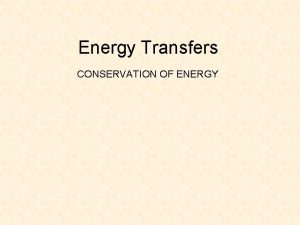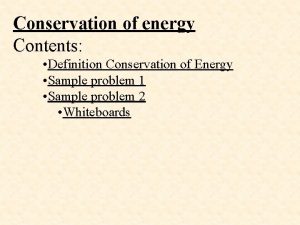CONSERVATION OF ENERGY Conservative Force A conservative force













- Slides: 13

CONSERVATION OF ENERGY

Conservative Force • A conservative force converts potential energy to other forms of mechanical energy when it does work. • In other words, a conservative force does not change the mechanical energy of a system • Remember that mechanical energy is potential energy + kinetic energy

Non. Conservative Force • So, what would be a nonconservative force? ? ? • Friction is most common example (air resistance is a form of friction) • Work done by friction becomes microscopic internal energy in the object, raising its temperature • The internal energy cannot be recovered and turned back into kinetic energy

Law of Conservation of Energy • Energy cannot be created or destoyed, only changed from one form to another • Ei = E f • KEi + PEi = KEf + PEf + HE • ½ mv 2 i + mghi = ½ mv 2 f + mghf + HE

Example

Example • A 65 kg snowboarder starts at rest, travels down a hill into a gulley and back up the other side as shown. Find his speed at top of the 2 nd hill.

Example • A 5. 0 kg block of wood is pushed down a ramp with a velocity of 6. 0 m/s. The ramp is 1. 5 m tall and 3. 5 m long. At the bottom of the ramp it is traveling at 7. 5 m/s. How much thermal energy is generated due to friction? Determine the force of friction and the coefficient of friction.

Work-Energy Theorem • Net work = change in kinetic energy. • This means that the net work on a system causes a change in speed of the system

Work-Energy Theorem • If you know how much energy you want a system or object to have, then you can calculate how much work you need to perform to get it there. Conversely, if you know how much energy a system has, you can calculate how much work that energy can perform. This has literally MILLIONS of real-life examples: • The energy of wind movement performs work when it turns a Wind Turbine • The chemical energy in gasoline performs work on a piston, which in turn performs work on a vehicle to create kinetic energy. • Work is performed on air as it enters a Jet Engine to speed up the air, which results in higher kinetic energy of the air particles, which pushes the airplane • Stirring a pot of water performs work in the form of heat transfer, which results in a higher temperature in the water (higher temp = higher energy) • When you throw a water balloon at someone’s face, their face performs work on the balloon, which then increases in pressure (higher pressure = higher energy) until it pops.

Example • A 60 kg sprinter exerts a net force of 260 N over a distance of 35 m. What is his change in kinetic energy? If started at rest, what is speed at finish?

Example • A student pushes a 25 kg crate which is initially at rest with a force of 160 N over a distance of 15 m. If there is 75 N of friction, what is the final speed of the crate?

In Summary • If there is a change in height in a system, you should use conservation of energy to solve the problem

Physics C Extras • Derivation of Work Energy Theorem
 Force conservative et non conservative
Force conservative et non conservative A motorcyclist is trying to leap across the canyon
A motorcyclist is trying to leap across the canyon The force of gravitation is conservative or nonconservative
The force of gravitation is conservative or nonconservative Conservative and non conservative forces
Conservative and non conservative forces Is electric potential conservative
Is electric potential conservative Chapter 7 energy conservation of energy
Chapter 7 energy conservation of energy Force conservative
Force conservative Conservation of energy
Conservation of energy Is thrust a conservative force
Is thrust a conservative force Physics 03-06 impulse and momentum answer key
Physics 03-06 impulse and momentum answer key Energy energy transfer and general energy analysis
Energy energy transfer and general energy analysis Energy energy transfer and general energy analysis
Energy energy transfer and general energy analysis Example of mechanical energy
Example of mechanical energy Bernoulli's constant
Bernoulli's constant

